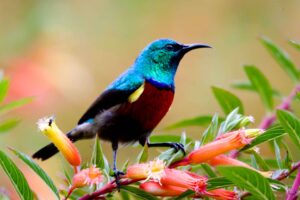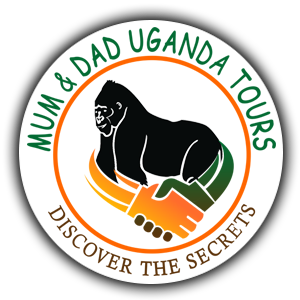Bigodi Wetland Sanctuary
The Bigodi Wetland Sanctuary is a community-based nature reserve located near Kibale Forest National Park in western Uganda. It is renowned for its rich biodiversity, including a wide array of bird species and other wildlife. Here’s some information about the Bigodi Wetland Sanctuary:
Location and Access:
The sanctuary is situated approximately 6 kilometers south of the town of Fort Portal, making it easily accessible for visitors. It is adjacent to Kibale Forest National Park, and many visitors combine a visit to the sanctuary with chimpanzee trekking in the national park.
Biodiversity:
The Bigodi Wetland Sanctuary covers an area of about 4.5 square kilometers and encompasses a diverse range of habitats, including swamp, grassland, and tropical rainforest. The sanctuary is home to over 200 bird species, including the Great Blue Turaco, African Pitta, and Papyrus Gonolek. It also harbors several primate species such as black-and-white colobus monkeys, red colobus monkeys, and grey-cheeked mangabeys.

Guided Nature Walks:
Visitors to the sanctuary can participate in guided nature walks led by knowledgeable local guides. These walks typically last around 2-3 hours and take you through the wetland trails. Offering opportunities to spot various bird species, primates, butterflies, and other wildlife. The guides are skilled at locating and identifying the different species. Providing valuable insights into the ecosystem and local conservation efforts.
Community Involvement and Conservation:
The Bigodi Wetland Sanctuary is a community-based initiative, managed and owned by the local community. The establishment of the sanctuary has not only contributed to the conservation of the wetland but also provided employment and income-generating opportunities for the community members. The revenue generated from visitor fees is used for community development projects, education, and healthcare initiatives.
Cultural Encounters:
Apart from the natural attractions, visitors to the Bigodi Wetland Sanctuary can also experience the local culture and traditions of the Batoro people. The community often arranges cultural performances. Where you can witness traditional dances, music, and learn about the customs and way of life of the local community.
A visit to the Bigodi Wetland Sanctuary offers a unique opportunity to appreciate the beauty of Uganda’s wetland ecosystem, observe diverse birdlife, encounter primates, and support community-led conservation efforts.
When to visit kibale national park
Kibale National Park in Uganda can be visited throughout the year, but the best time to visit depends on your preferences and priorities. Here are some considerations for each season:
Dry Season (December to February and June to September):
The dry season is generally considered the best time to visit Kibale National Park. During this period, the weather is typically dry and sunny, making it easier to navigate the park’s trails and enjoy outdoor activities. It’s also the peak tourist season, so expect more visitors during this time. Wildlife sightings, including chimpanzee trekking, are usually good throughout the dry season.
Wet Season (March to May and October to November):
The wet season in Kibale National Park brings rainfall and occasional thunderstorms. The park becomes lush and green, and the landscape is vibrant. Although the rain can make trekking more challenging, it also provides a unique atmosphere and the opportunity to see the park in its full splendor. The wet season is a quieter time in terms of tourism. So you may encounter fewer crowds and have a more intimate experience with the wildlife.

Chimpanzee Mating Season (July to September):
If your primary goal is chimpanzee trekking, consider visiting during the chimpanzee mating season, which typically occurs from July to September. During this time, the chimpanzees are more active and vocal as they engage in mating behaviors, which can make for an exciting and immersive wildlife experience.
It’s worth noting that weather patterns can vary, and there can be regional variations within Uganda. Therefore, it’s always a good idea to check the weather forecast and consult with local tour operators or travel agencies to determine the most suitable time to visit based on your specific interests and preferences.
related safari
8days gorillas, wildlife chimpanzee trekking
5 days primates and wildlife safari
